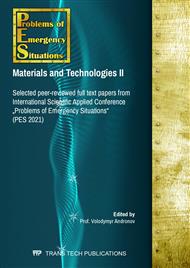p.119
p.129
p.137
p.144
p.154
p.162
p.168
p.177
p.185
Experimental Substantiation of Antimicrobial Efficiency of a New Composite Polymeric Material Based on Poly(2-Hydroxyethyl Methacrylate) under the Action of Low-Intensity Current without External Power Supplies
Abstract:
Active use of polymeric materials has become an integral part of all areas of modern medicine. Wound dressings capable of prolonged release of drugs directly into the lesion occupy a special place among them. The possibility of using such materials in the presence of low-intensity currents without external power supplies in a comprehensive treatment program for patients with burn injuries remains promising. The aim of the work is to study experimentally the antimicrobial efficacy of a new composite polymeric material based on poly(2-hydroxyethyl methacrylate), saturated with the antiseptic decamethoxine, under conditions of low-intensity current without external power supplies. The method of free radical thermal polymerization of a mixture of liquid monomer 2-hydroxyethyl methacrylate, crosslinking agent triethylene glycol dimethacrylate, polymerization initiator azobisisobutyronitrile was used for the synthesis of composite polymeric material. In addition, fourfold volume of distilled water as a pore-forming agent and decamethoxine as an antimicrobial component were administered. Known dressings of synthetic and biological origin were selected for comparison, some of which were pre-soaked in a 0.02% solution of decamethoxine. The study of conductivity of the materials without external power supplies was performed on the surface of a dense nutrient medium in a Petri dish using VITA-01M measuring device. Determination of antibacterial properties was performed by diffusion into agar. The obtained results allowed to establish the ability of the suggested polymeric material to conduct low-intensity currents without external power supplies, exceeding the duration of other traditional dressings. Comparison of antimicrobial activity of the studied samples confirmed the synergism of the action of physical factors and a new polymer-based composite material with the addition of antimicrobial substance to inhibit the growth of the test museum and clinical strains of Staphylococcus aureus. The ability of low-intensity currents without external power supplies to potentiate the antimicrobial properties of a new composite polymeric material based on poly(2-hydroxyethyl methacrylate), modified with a pore-forming agent, with the addition of decamethoxine was experimentally established.
Info:
Periodical:
Pages:
154-161
Citation:
Online since:
July 2021
Price:
Сopyright:
© 2021 Trans Tech Publications Ltd. All Rights Reserved
Share:
Citation:


